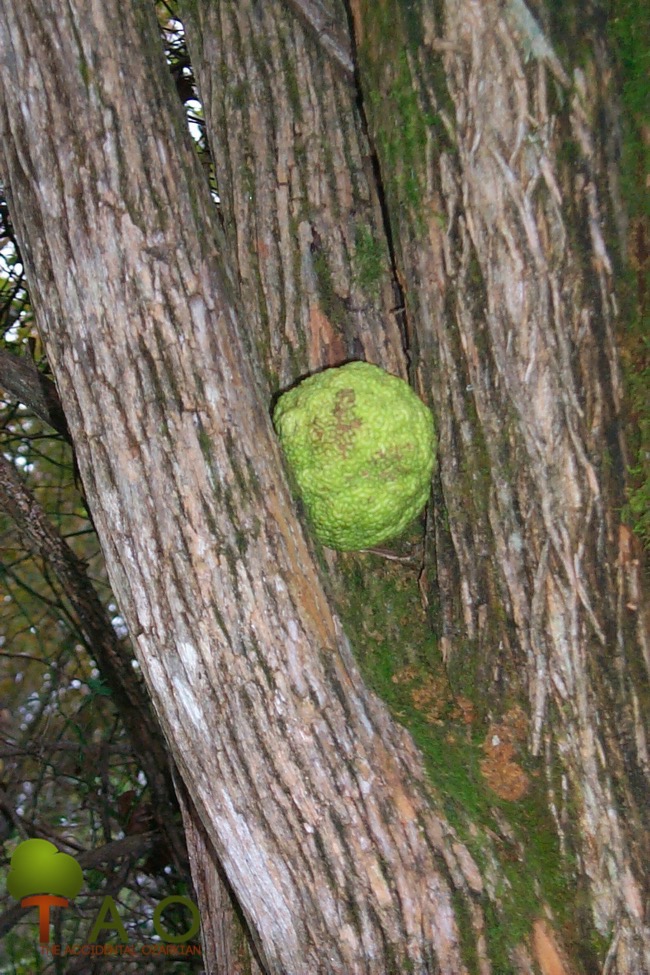“Yeah, sure, I know where there are lots of hedge apples,” said my father-in-law, Jake. Then he agreed to take us to find them. We crawled into the back of his old pick-up truck, alongside a recently discarded oven, to ride the bumpy route that took us down a wooded trail, over a couple of creeks, and through an old pasture full of thistles to the north end of his property.
All along the way, the truck’s front fenders brushed thistles and grass in the pasture, releasing what seemed like millions of seeds into the air around us. It was like being in a ticker-tape parade, and we dared not open our mouths.
We disembarked from the truck, picked ourselves clean of seeds, and walked through briar patches and stumbled along in the path of a dry creek bed. We turned another corner and found the ground covered in hedge apples.
A gnarled Osage orange tree stood at the edge of the creek and stretched about 30 feet high. Also known as the bodark, the bois d’arc, or the bowwood tree, its twisted branches extended in all directions, giving it an ominous look. With its shaggy gray strips of bark, the tree looked as though it had been picked up, twisted a time or two, and set back down in place.
 This tree was definitely a female, with hundreds of hedge apples lying at her feet. Her leaves were yellow, and her branches sported dangerous-looking half-inch spines. This tree was a perfect Halloween tree—gnarled, twisted and dropping green brains all over the place.
This tree was definitely a female, with hundreds of hedge apples lying at her feet. Her leaves were yellow, and her branches sported dangerous-looking half-inch spines. This tree was a perfect Halloween tree—gnarled, twisted and dropping green brains all over the place.
Some folks compare the hedge apple to a green brain, and author Christopher Cooper (Wisscaset, Maine newspaper, Dec. 1999) writes, “It looks like nothing so much as a perfectly round, green brain. Its surface is convoluted in exactly that cerebral fashion.”
Actually, the convolutions on the surface are one-seed drupelets, or separate ovaries. Each drupelet springs from a female flower. Sometimes, you’ll spot a black hair, called a style, coming from each ovary. About this time of year, the tree releases her fruits and you’d best hope you’re not sitting under one of them, reading a good book or lying in your hammock. The softball size fruits could raise a ripe pop-knot on your head in a matter of minutes.
Back in the early days of civilization in the Ozarks, the Osage Indians in Arkansas and Missouri preferred Osage orange wood for bows. The wood is stronger than oak and as resilient as hickory.
Lewis and Clark sent an Osage orange tree back east. Supposedly, it’s the first tree they sent home. Today, the largest Osage orange tree stands in the yard of Patrick Henry’s home in Virginia, because Henry’s daughter planted the seed at Red Hill. Settlers to the Ozarks planted the trees to form natural hedgerows.
A yellow-orange dye which comes from the wood after it is freshly cut, is used in industry. The grain of the Osage orange does not shrink or swell like other woods, and is used for fence posts, insulator pins, treenails, furniture, and, of course, archery bows.
The hedge apple has even been featured in Martha Stewart’s magazine, “Living.” Supposedly, Martha promotes using the hedge apple as decorations. In fact, if you can’t get out and find your own hedge apples, you may order them on line: a baker’s dozen will cost you $35, plus shipping and handling.
You may, however, prefer to go looking for the sometimes-elusive Osage orange tree, preferring to enjoy an afternoon walk in the autumn Ozarks woods, while getting a little exercise and a lot of fresh air. Remember to take a sturdy bag, and only to load what you can carry.
First published in Oct. 2002.




